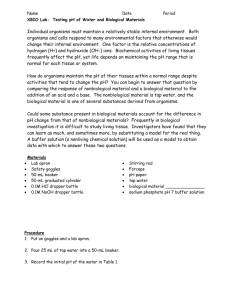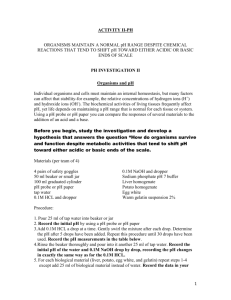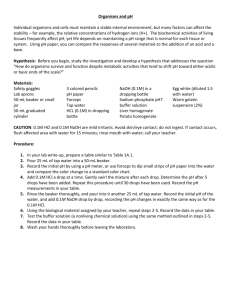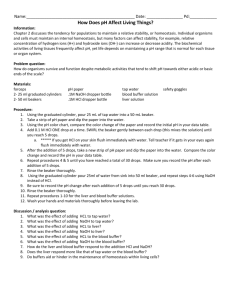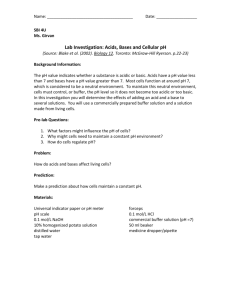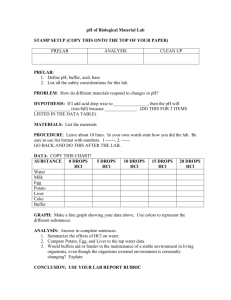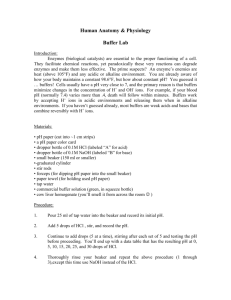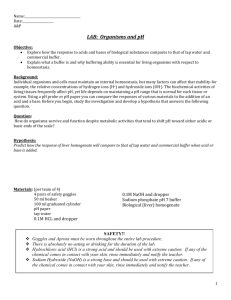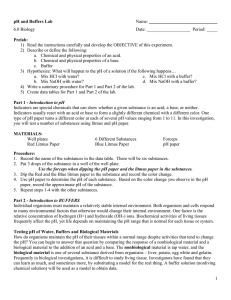Measuring the pH of Biological Material After The Addition of HCL or
advertisement
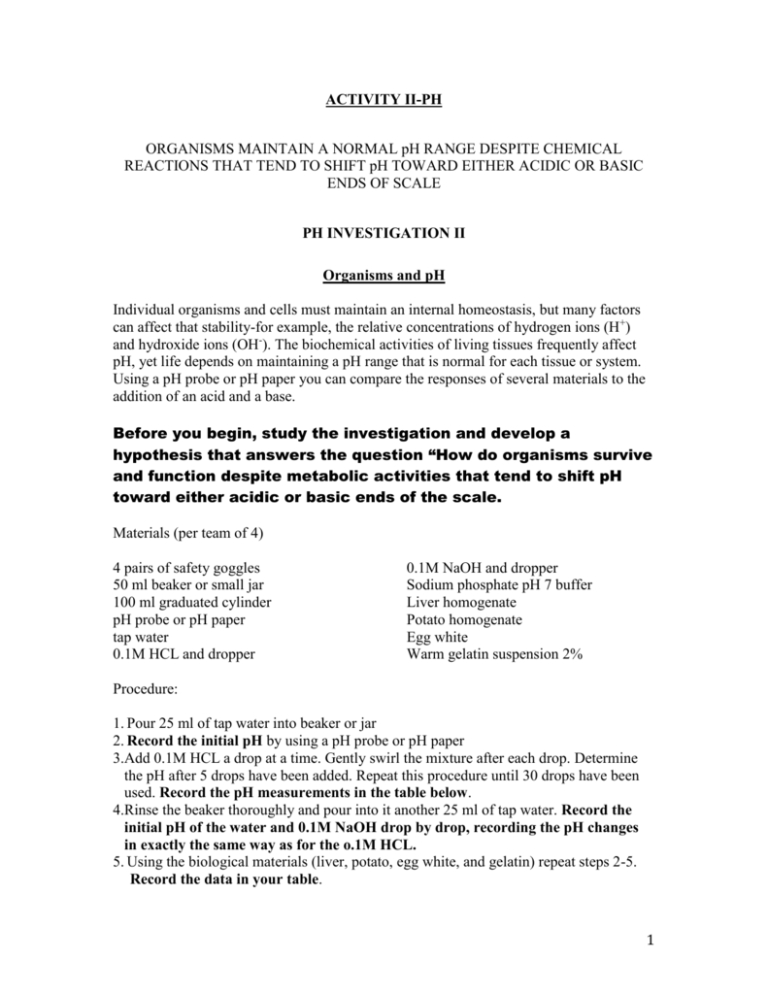
ACTIVITY II-PH ORGANISMS MAINTAIN A NORMAL pH RANGE DESPITE CHEMICAL REACTIONS THAT TEND TO SHIFT pH TOWARD EITHER ACIDIC OR BASIC ENDS OF SCALE PH INVESTIGATION II Organisms and pH Individual organisms and cells must maintain an internal homeostasis, but many factors can affect that stability-for example, the relative concentrations of hydrogen ions (H+) and hydroxide ions (OH-). The biochemical activities of living tissues frequently affect pH, yet life depends on maintaining a pH range that is normal for each tissue or system. Using a pH probe or pH paper you can compare the responses of several materials to the addition of an acid and a base. Before you begin, study the investigation and develop a hypothesis that answers the question “How do organisms survive and function despite metabolic activities that tend to shift pH toward either acidic or basic ends of the scale. Materials (per team of 4) 4 pairs of safety goggles 50 ml beaker or small jar 100 ml graduated cylinder pH probe or pH paper tap water 0.1M HCL and dropper 0.1M NaOH and dropper Sodium phosphate pH 7 buffer Liver homogenate Potato homogenate Egg white Warm gelatin suspension 2% Procedure: 1. Pour 25 ml of tap water into beaker or jar 2. Record the initial pH by using a pH probe or pH paper 3.Add 0.1M HCL a drop at a time. Gently swirl the mixture after each drop. Determine the pH after 5 drops have been added. Repeat this procedure until 30 drops have been used. Record the pH measurements in the table below. 4.Rinse the beaker thoroughly and pour into it another 25 ml of tap water. Record the initial pH of the water and 0.1M NaOH drop by drop, recording the pH changes in exactly the same way as for the o.1M HCL. 5. Using the biological materials (liver, potato, egg white, and gelatin) repeat steps 2-5. Record the data in your table. 1 6.Test the buffer solution (a nonliving chemical solution) using the same method outlined in steps 2-5. Record the data in your table. 7. Wash your hands Measuring the pH of Biological Material After The Addition of HCL or NaOH Tests with 0.1M HCL Tests with 0.1M NaOH pH after addition of # of drops of HCL Solution tested 0 5 10 15 20 25 pH after addition of # of drops of NaOH 30 0 5 10 15 20 25 Tap water Liver Potato Egg white Gelatin Buffer 2 30 DISCUSSION QUESTIONS: 1. Summarize the effects of HCL and NaOH on tap water 2.What was the total pH change for the 30 drops of HCL added to the biological material? For the 30 drops of NaOH added? How do these data compare with the changes in tap water? 3. Make two graphs of your data a. pH versus the number of drops of acid. Create a line for tap water, liver, potato, and buffer b. pH versus the number of drops of base. Create a line for tap water, liver, potato, and buffer 4. How do biological materials respond to changes in pH? 5. How does the buffer system respond to HCL and NaOH? 6. Is the pH response of the buffer system more like that of water or the biological material? 7. How does the reaction of the buffer solution serve as a model for the response of biological materials to pH changes? 8. Would buffers aid or hinder the maintenance of homeostasis within a living cell in a changing environment? 9. What does the model suggest about the mechanism for regulating pH in an organism? 10. What served as the control? 11. What served as the experimental variables? 12. What was the independent and dependent variable? LAB WRITE UP: 1. 2. 3. 4. Data table Two graphs (from question 3 under discussion) Word processed responses to Discussion questions 1-12 Web-based research: An important buffer system in humans that helps maintain the pH of the blood at 7.4 is known as the carbonic acid- bicarbonate buffer system. This is extremely important because a slight deviation from this blood pH for too long is deadly. Maintaining the pH of blood at 7.4 is part of maintaining homeostasis. Look up the carbonic acid- bicarbonate buffer system on the Internet and explain how it works. 1. How does exercise affect the pH of the blood? 2. How does increased breathing during exercise help off set the change in blood pH from exercise? 3. What role do kidneys play in maintaining blood pH? 4. What equation describes the carbonic acid-bicarbonate system? Explain 5. Which way would the equation shift if excess hydrogen ions were added to the blood? Why? 3 6. Which way would the equation shift if hydroxide ions were added to the blood? Why? 7. If blood pH can’t be maintained and the pH raises it is called Alkalosis. What are the symptoms of alkalosis? 8. If the blood pH can’t be maintained and the pH lowers it is called acidosis? What are the symptoms of acidosis? Cite your sources 4
